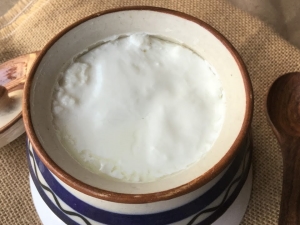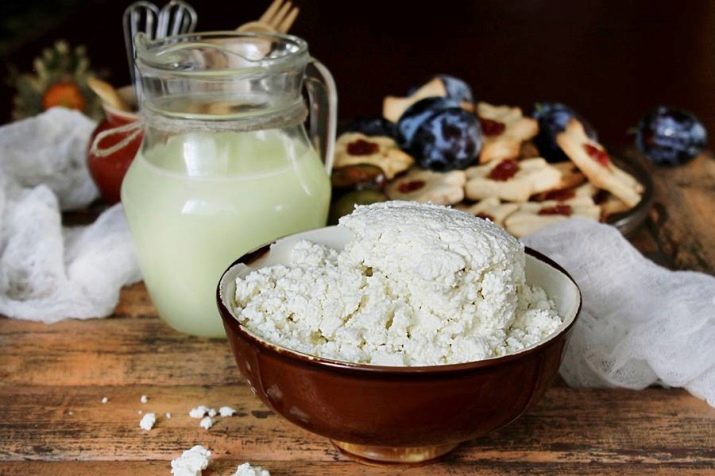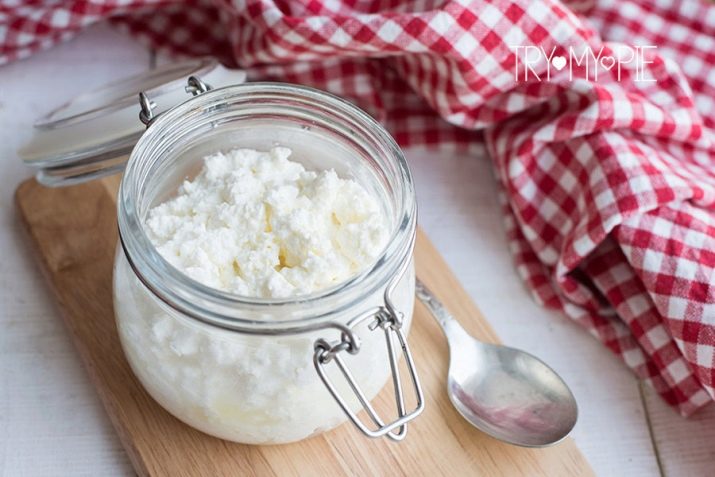Calorie and fat content of homemade curd

Home-made cottage cheese is considered by many to be tastier than shop-based, cooked on an industrial scale. It is perfect for baking, creams, cakes, cottage cheese desserts, cheesecakes and casseroles.Many people prefer to use it as an independent dish with honey, sour cream, canned and fresh fruit. The inclusion of cottage cheese in the diet allows you to provide the body with proteins, fats, beneficial vitamins and minerals.
What are they doing and how?
Everyone knows that the raw material for the production of dairy products is milk. Cottage cheese can be made both from cow's milk and from the milk of other domestic animals, for example, from goat or sheep, as well as from more exotic raw materials - camel and horse milk. At home for the manufacture of cottage cheese used fermented milk or cream. The most delicious and appetizing product is obtained from homemade milk. Of course, in his absence, you can use and store.
Before cooking, the milk is left in a warm place for fermentation. Once the yogurt is ready, you can put it on fire. With periodic stirring, you need to monitor what is happening in the pan - yogurt should curl. Then, the resulting curd mass is thrown back onto gauze or a piece of cloth, tied up and hung up in order for the glass to be whey. It is very important not to overdo sour milk on the stove, otherwise the curd will be hard.
Calorie and fat content
The fat content of cottage cheese directly depends on the fat content of the raw materials from which it is prepared. If store raw materials are used, marked with the indication of fat content, then it will not be difficult to determine the corresponding indicator in the finished product; there are special formulas for this.
Another thing, if for the manufacture of homemade cottage cheese is used homemade village milk. To determine its fat content is almost impossible. Although theoretically this is a completely acceptable procedure using special devices, usually farmers and holders of the farmstead do not do this, and the quality of milk is determined simply by taste.
Then, speaking of the fat content of milk, you can only sound approximate values. Most often, the cottage cheese turns out to be fat, since for its production they use not only fat milk, but also cream, which are just as fat. They give the finished curd a yellowish or creamy shade, as well as a soft, pasty consistency.
Speaking of the fat content of the curd, imply the following gradation of this indicator: fat-free - 0%, low-fat - up to 5%, low-fat - up to 9%, high-fat content - up to 18%. Home-made products are in most cases high-fat products.
Calorie curd depends on its fat content. The higher the fat content, the more calories in it, the higher its nutritional value, and for each percentage of fat content accounts for about 9 calories (kcal). Calorie cottage cheese can be in the range from 80 to 236 kilocalories per 100 grams. As a rule, this value is close to the maximum.
Low calorie content is obtained from cottage cheese made from store milk without adding cream to raw materials, or from skim milk.
Skimmed milk is obtained by separation using special devices. At the same time get the cream and the separated liquid, which is skim milk (reverse). If the cottage cheese is made from skimmed milk, then its caloric content is minimal. This product is recommended for people with obesity, atherosclerosis, suffering from stomach disorders, with liver diseases.
Benefit
The benefits of cottage cheese are due to its composition, which is rich in nutrients and vitamins.
- It surpasses other products in the amount of valuable protein in its composition. Protein cottage cheese perfectly split and easily absorbed by the body.
- Due to its high nutritional value and excellent digestibility, this fermented milk product is introduced into the nursery and diet and is recommended for the elderly.
- Despite the high calorie content, cottage cheese is included in weight loss programs, since the optimal ratio of proteins, fats and carbohydrates is necessary for normalization of metabolism.
- Cottage cheese is rich in vitamins such as: PP (nicotinic acid), B1 (thiamine), B2 (riboflavin), C (ascorbic acid), E (tocopherol), beta-carotene.
- Mineral substances that make up the cottage cheese, ensure the development and normal functioning of the body. It contains the minerals needed to build teeth, bones and soft tissues (calcium, magnesium, phosphorus, potassium).
- Cottage cheese contains essential amino acids, such as methionic and tryptophan. They are involved in the process of blood formation, protect the liver from fat deposits, help to normalize the work of the biliary tract.
- Regular consumption of cottage cheese favorably affects the condition of the skin and hair. They become stronger, get a healthy look.
- Also, cottage cheese substances help to improve the conductivity of nerve impulses, that is, the ability of nerve fibers to perceive irritation, making connections between the organism between its systems and its environment.
- The use of cottage cheese on an ongoing basis improves the immune processes and resistance to colds.
- In addition, it has a prophylactic effect on cancer.
Possible harm
There are some contraindications.
- Without proper laboratory tests, one cannot be completely confident in the safety of cottage cheese.
- Individual allergic reactions to milk protein casein.
- Products that have expired may cause severe poisoning.
- The use of fat cottage cheese in excess amount may not in the best way affect the work of the liver.
For the benefits and harm of cottage cheese, see the following video.


























